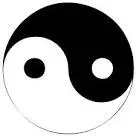by Qineng Tan, L.Ac., Ph.D.
The concept of Yin and Yang is central not only to the ancient Chinese phil osophy called Taoism, but also to the philosophy and practice of Traditional Chinese Medicine. It is a concept of dualism, meaning that everything in the Universe is made up of two opposing, yet interdependent, forces. One type of energy will lead to the other, and back again, over and over: day into night, darkness into light, birth into death, and so on. Without Yang, there is no Yin, and without Yin there can be no Yang. They cannot exist independently.
osophy called Taoism, but also to the philosophy and practice of Traditional Chinese Medicine. It is a concept of dualism, meaning that everything in the Universe is made up of two opposing, yet interdependent, forces. One type of energy will lead to the other, and back again, over and over: day into night, darkness into light, birth into death, and so on. Without Yang, there is no Yin, and without Yin there can be no Yang. They cannot exist independently.
You have seen the Yin-Yang symbol many times: two teardrop shapes, one black, one white, chase each other around in a circle. Inside each teardrop is a small circle of the opposite color. This visual representation of Yin-Yang serves as a reminder that within each type of energy, some of the other is also lurking, and vice versa.
In Mandarin Chinese, the character for Yin – 阴 – can have several meanings, including: “feminine,” “moon,” and “cloudy.”
The Yang character – 阳 – means “masculine,” “sun,” and “bright.”
Yin-Yang is not just about opposites, though, and to reduce it to ideas like male-female, or dark-light, is too simplistic. Yin-Yang is about transformation–the biggest, most meaningful transformations that occur in our lives and in the world all around us. It is also about balance. The dual energies of Yin and Yang must work in harmony at all times. If there is too much of one energy, there will be too little of the other, and something will have to change in order to restore the balance.
This is where the concept of Yin-Yang comes into play in Traditional Chinese Medicine. Illness occurs in the body when there is an imbalance of energies. Imbalances will show up as problems in the organ systems. Some organs relate the to Yin meridian (including the kidney, liver, lungs, spleen and heart), while others relate to the Yang meridian (stomach, large intestine, small intestine, gall bladder).
Considering the functions of the human body, Yang refers to active energy and heat, while Yin is passive energy, and cold. When a patient comes to us, we are looking and listening closely to find out how the imbalance is revealing itself. For example, swelling is a Yin condition, while pain is a Yang condition. Once we have begun to determine the nature of the imbalance, we will not only perform acupuncture, but also prescribe herbs and specific foods, as well as lifestyle changes, that will help restore the balance of Yin and Yang in the body.
Because you cannot have Yang without Yin, and so on, we focus on keeping both parts alive and strong. If you kill the Yin energy, you will also kill the Yang energy. In Chinese medicine, when we want to increase or strengthen one kind of energy, we call it “tonification.” Reduction, or calming, of energy is “restoring.” So, if a patient has, for example, excessive Yang and weak Yin, we will work to tonify the Yin and restore the Yang.
According to the philosophy of Yin and Yang, even the worst situation has some positivity hiding within it. So, we always look for the other side. As you travel along on your personal journey towards optimal health, keep in mind that pain and illness appear to show you where you need to work to create balance in your own life.
